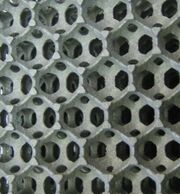Difference between revisions of "Aluminum foam"
Jump to navigation
Jump to search

| Line 2: | Line 2: | ||
[[File:Al foam formed.jpg|thumb|Formed aluminum foam from Wikipedia [https://commons.wikimedia.org/wiki/File:Alv%C3%A9oles_4.jpg link]]] | [[File:Al foam formed.jpg|thumb|Formed aluminum foam from Wikipedia [https://commons.wikimedia.org/wiki/File:Alv%C3%A9oles_4.jpg link]]] | ||
==Description== | ==Description== | ||
| − | Lightweight metallic sheets usually formed air or gas injected into the molten aluminum. Aluminum foams are very strong, nonflammable and eco-friendly. | + | Lightweight metallic sheets usually formed air or gas injected into the molten aluminum. Aluminum foams are very strong, nonflammable and eco-friendly. They have excellent impact absorption and are used for collision protection in transport systems; however, unlike polymer foams, when an impact happens, they remain deformed and can only be used once. |
| + | Foamed metals are available both in closed cell and open cell forms. | ||
* Open-celled metal foams are usually replicas produced using open-celled polyurethane foams as a skeleton | * Open-celled metal foams are usually replicas produced using open-celled polyurethane foams as a skeleton | ||
| − | * Closed-cell metal foams have been developed since the 1950s, but although prototypes were available, commercial production was started only in the 1990s. | + | * Closed-cell metal foams have been developed since the 1950s, but although prototypes were available, commercial production was started only in the 1990s. They made by injecting a gas into molten metal forming pores, or cells, about 1 to 8 mm in size. |
== Synonyms and Related Terms == | == Synonyms and Related Terms == | ||
| Line 13: | Line 14: | ||
==Applications== | ==Applications== | ||
| − | * Sound insulation | + | * Sound and impact insulation |
* Architectural facades | * Architectural facades | ||
* Lightweight case construction | * Lightweight case construction | ||
Latest revision as of 12:19, 7 February 2024

Formed aluminum foam from Wikipedia link
Description
Lightweight metallic sheets usually formed air or gas injected into the molten aluminum. Aluminum foams are very strong, nonflammable and eco-friendly. They have excellent impact absorption and are used for collision protection in transport systems; however, unlike polymer foams, when an impact happens, they remain deformed and can only be used once.
Foamed metals are available both in closed cell and open cell forms.
- Open-celled metal foams are usually replicas produced using open-celled polyurethane foams as a skeleton
- Closed-cell metal foams have been developed since the 1950s, but although prototypes were available, commercial production was started only in the 1990s. They made by injecting a gas into molten metal forming pores, or cells, about 1 to 8 mm in size.
Synonyms and Related Terms
foamed aluminum; metal sponge
Commercial products: Duocel
Applications
- Sound and impact insulation
- Architectural facades
- Lightweight case construction
- Heat exchangers
Physical and Chemical Properties
- Lightweight with high strength to weight ratio
- Density (relative to solid As) = 4-12% is most common
- Compression strength = 367 psi (at 8% relative density)
- Tensile strength = 180 psi (at 8% relative density)
- Melting point = 1220f (660C)
Working Properties
- Carbide- or diamond-tipped blades are required for machining
- Joined by brazing, adhesive bonding, mechanical fasteners, or soldering
Forms and Sizes
- Thicknesses from 1/2" to 2"
- Sheets available 6'x6' or 12'x12' (McMaster-Carr)
Resources and Citations
- Wikipedia: Metal foam Accessed Feb. 2024
- American Elements: Foams
- McMaster-Carr: Aluminum foam
